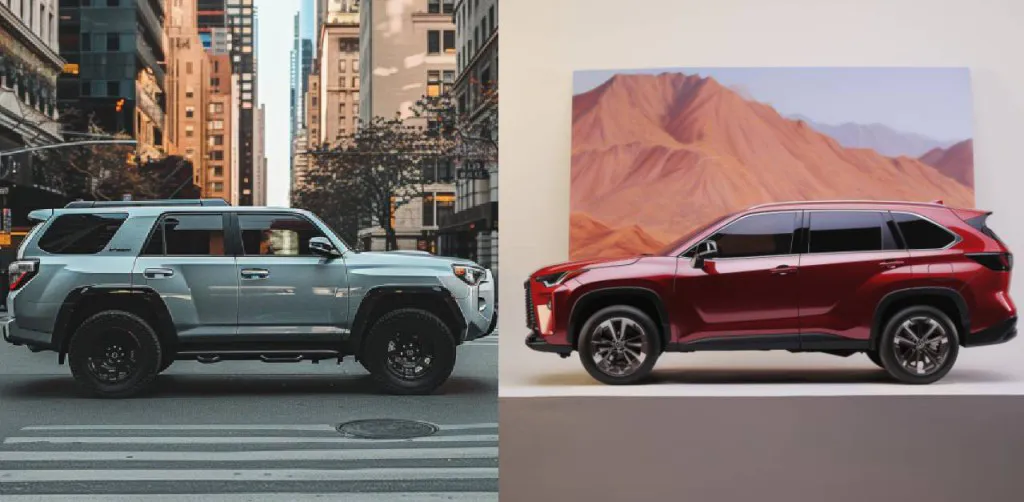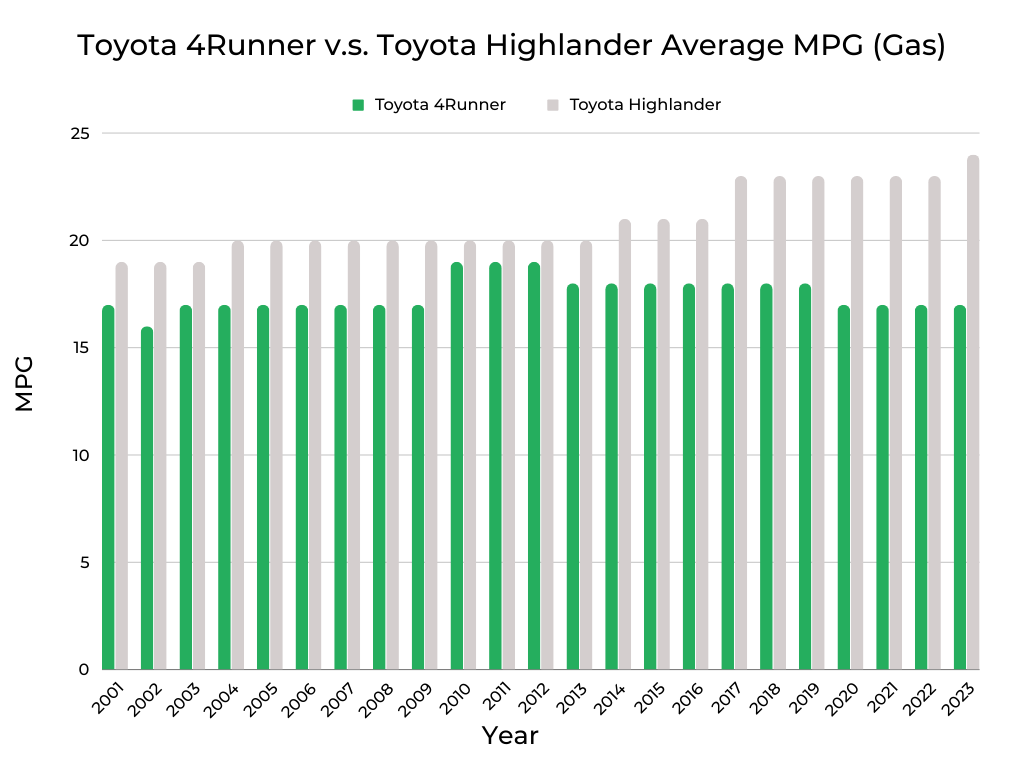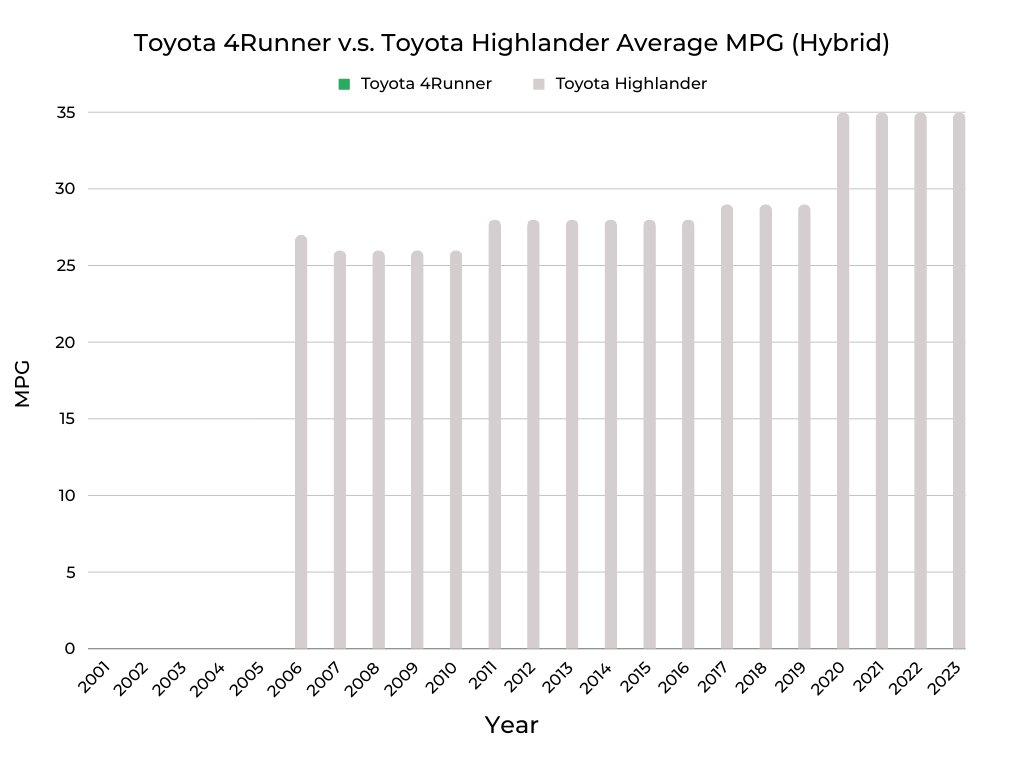In Toyota’s world of SUVs and crossovers, the 4Runner and Highlander are among the company’s best sellers (the RAV4 takes the top spot). Calling these vehicles popular is an understatement. This success leads to a vibrant second-hand market.
Yet there’s a lot to consider when choosing between a used 4Runner and Highlander. While they’re both Toyota utilities, each takes a different approach to getting the job done.
The 4Runner is an off-road champion that chews up rough terrain with ease. Yet this off-pavement prowess comes at the expense of comfort and refinement. The couple of times I’ve driven a 4Runner, I felt very confident while traversing a trail but wished for something not so truck-like on the road. This is no surprise as the 4Runner shares much with the Toyota Tacoma.
What the Highlander lacks in off-road chops is made up for by oodles of functionality. There’s abundant room in the first and second rows, while the third row can help in a pinch (or with small kids). Above all, the Highlander has a compliant and comfortable ride that won’t tire you out after a road trip. Its Camry DNA is evident. There’s nothing to get excited about here, but that’s the point of the Highlander. It completes its tasks without being noticed. Vanilla ice cream has its fans.
There are other realities to think about when comparing the 4Runner and Highlander. A higher sticker price and lower depreciation means you’ll pay more for a 4Runner than a comparable Highlander. On the plus side, the 4Runners’ less-sophisticated mechanicals help with lower maintenance and repair costs. You can also make a case that its more basic systems give the 4Runner better odds for a longer lifespan.
Meanwhile, you’ll find that the Highlander has its strengths. In particular, this family hauler has a better fuel economy, especially as a hybrid. In addition, the Highlander unfailingly outperforms the 4Runner in government crash tests.
Both vehicles have their ups and downs with engine reliability. The FIXD Reliability Score (which measures engine dependability) fluctuates greatly between 4Runner and Highlander model years. You’ll want to pay close attention to this as I break down the details later.
Looking for the latest model? Explore: Toyota 4Runner Vs. Toyota Highlander | 2023 Comparison.
Keep reading to see how this Toyota 4Runner and Toyota Highlander contest turns out. Other match-ups to review include Outback vs. Forester, RAV4 vs. CR-V, Highlander vs. Corolla, Pilot vs. Highlander, and Odyssey vs. Sienna.
| Income Bracket | Monthly Financing Cost Range | Cash Purchase Price Range | Toyota 4Runner Years | Toyota Highlander Years | Best Model Year: | Why? |
| $5k-$10k | $83-$125 | $3,000-$4,500 | N/A | 2002 | 2002 Highlander | Low Price |
| $10k-$15k | $125-$187 | $4,500-$6,750 | 2004 | 2007 | 2007 Highlander | Good value, strong safety score, and above-average engine reliability |
| $15k-$25k | $187-$312 | $6,750-$11,250 | 2008 | 2010 | 2008 4Runner | Good value, above-average engine reliability |
| $25k-$35k | $312-$437 | $11,250-$15,750 | 2012 | 2015 | 2015 Highlander | Top engine reliability score, strong safety score |
| $35k-$50k | $437-$625 | $15,750-$22,500 | 2015 | 2017 | 2015 4Runner | Good engine reliability score, strong value |
| $50k-$74k | $625-$925 | $22,500-$33,300 | 2020 | 2019 | 2019 Highlander | Good engine reliability score, solid value, and strong safety score |
| $75k-$99k | $925-$1,238 | $33,300-$44,550 | 2021 | 2021 | 2021 Highlander | Top engine reliability score, very good safety score, |
See the methodology for the table above.
Before you respond to the “For Sale” ad, check out this How to Buy a Used Car article for a step-by-step checklist.
Price History Comparison | Toyota 4Runner Vs. Toyota Highlander
Average Market Value – Based on Owners’ Self-Reported Mileages | Toyota 4Runner Vs. Toyota Highlander
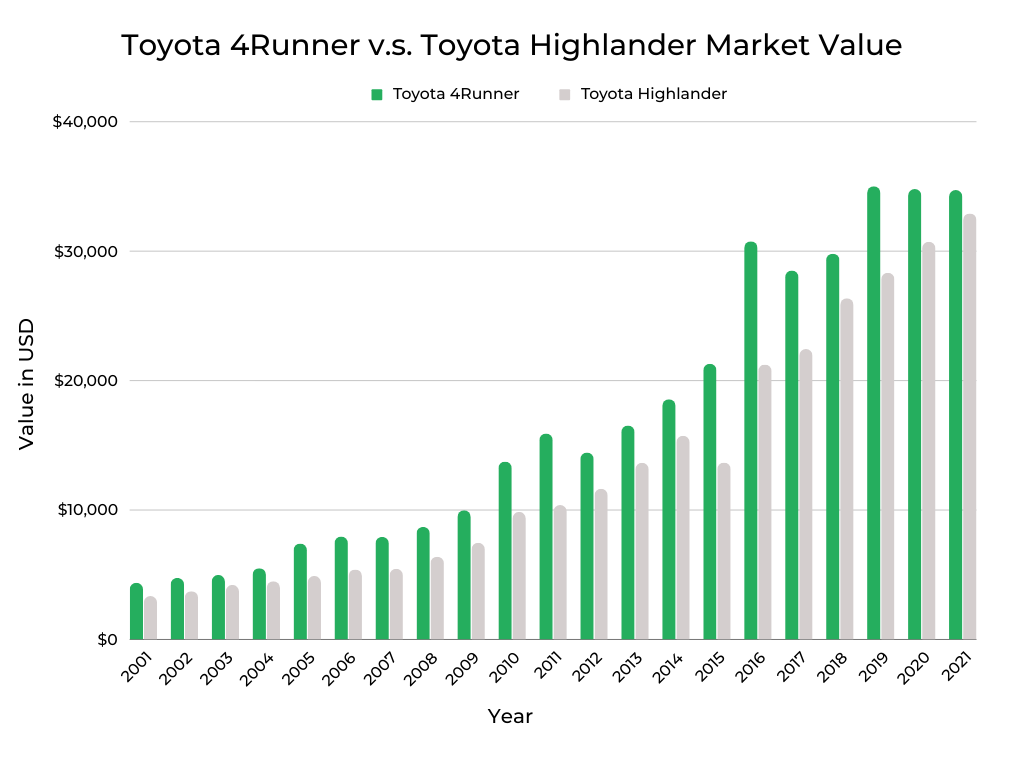
Shopping for a second-hand 4Runner or Highlander often begins with a look at prices. The graph shows the Kelley Blue Book (KBB) average private-party transaction amount for 20th-century 4Runners (green) and Highlander (gray) through 2021. The amounts would increase by 33%–50% at a dealer. If the extra cost of a retail purchase doesn’t match your budget, you can either look for a private seller or adjust your shopping parameters (look for a vehicle that’s older or has higher mileage).
You’ll notice that the 4Runner has consistently higher values than the Highlander. There are two reasons for this effect: the 4Runner has had a higher MSRP and lower depreciation over the years.
Generally, Toyotas do an excellent job of holding their value, but some models are better than others. Among the better nameplates in this area is the 4Runner. Caredge.com estimates that a 4Runner loses only 19% of its original value after five years. The Highlander is no slouch either in value retention, dropping an estimated 21% at the end of five years.
The 2% difference may not seem like much, but factor in higher original prices, and you’ll learn why buying a used 4Runner costs more than a relatively equivalent Highlander.
You’ll notice price fluctuations for the 2015 Highlander and 2016-2017 4Runner. These variances stem from above- or below-average mileage (as the case may be) for the respective model and model year. The KBB data also reflects owner-reported mileage as collected via FIXD surveys.
Be sure to read our Best and Worst Years series of articles highlighting the Toyota 4Runner and Toyota Highlander winners and losers.
Depreciation vs. Maintenance Expenses
As mentioned, depreciation is a nasty side effect of buying a new car. Yes, Toyotas hold their value better than many other makes, but it’s still an issue. Savvy buyers looking to maximize their budget will turn to older cars less impacted by depreciation. In other words, the worst has already occurred.
Often, the target range starts after about a decade. However, the ideal model years to maximize value are much older because the 4Runner and the Highlander don’t depreciate so quickly. Yet, focusing on the model year alone can be a mistake. Repair and maintenance costs also have to be taken into consideration.
In short, you want to balance low depreciation and reasonable repair bills. This creates “sweet spot” opportunities highlighted in the black-outlined box in the respective charts for the 4Runner and Highlander. This means a window of opportunity with 2002-2006 4Runners or 2003-2008 Highlanders. I’ll look closer at 4Runner and Highlander upkeep costs later in the article.
But don’t assume every example within these ranges is a smart buy. Learn more by reviewing the best and worst years of the Toyota 4Runner and Toyota Highlander. There’s also an at–a–glance summary towards the end of this article.
Reliability Comparison | Toyota 4Runner Vs. Toyota Highlander
Two ratings are at the core of our look at the Toyota 4Runner and Toyota Highlander.
- The FIXD Reliability Score measures the number of check engine lights recorded for a particular model year by installed FIXD sensors. Think of it as an engine reliability score. While every check engine light doesn’t directly translate into reliability concerns (such as a dead battery or loose gas cap), these indicators still provide insight into a car’s dependability. This data is weighted by mileage.
- The second rating is the Owner Reliability Score. This is a subjective ranking of how surveyed owners feel about their respective vehicle’s dependability. Each owner estimates how capable their car is for trips of different lengths. A vehicle that can handle a cross-country adventure receives the highest score, while a car only suitable for a quick point A to point B trip gets the lowest score.
Both rankings are based on 1 being the lowest, 10 being the highest, and 5 being the average score.
We’ll also point out that both scores seldom align. The FIXD Reliability Score is determined by a definitive number, the frequency of check engine lights. On the other hand, the Owner Reliability Score is opinion-based. Owners tend to have pride in their automobiles, with higher ratings as a result. At a minimum, those with older vehicles are more accepting of check engine lights. For many, it’s the price of owning an aging car.
When it comes to engine reliability, the early years (2001-2011) of the 4Runner and the Highlander aren’t a pretty picture. Most of these examples rank a 4 (out of 10) or worse for engine reliability. And the few model years that exceed this poor showing only rise to a 5 or 6— so much for Toyota’s vaunted reputation for reliability.
To be fair, age can exact a toll on any vehicle. But shoppers focused on an older 4Runner or Highlander should start the buying process with their eyes wide open.
However, FIXD Reliability Scores improved beginning with the 2012 model year. In particular, the 4Runner shines, with most later editions scoring an 8 or better. The 2016 (1) and 2019 (5) editions are notable exceptions. FIXD Reliability Scores never dip below a 6 with newer Highlanders. Further, 70% of 2012-2012 scored at least a 7, while 50% received a ranking of 8 or above.
It’s worth mentioning that many conditions can trigger a check engine light (CEL). Sometimes, all it takes is a loose gas cap or a disconnected wire.
Those with a 4Runner or Highlander in the driveway are less concerned about check engine lights. Owner Reliability Scores never drop below a 7 for the 4Runner and 6 for the Highlander. In fact, most of these scores hover between 8 and 10. This tells me that owners accept CELs or don’t consider minor issues an impact on reliability.
Review the Best and Worst Years articles on the Toyota 4Runner and Toyota Highlander to learn more about these vehicles’ FIXD Reliability and Owner Reliability Scores.
Longevity Comparison | Toyota 4Runner Vs. Toyota Highlander
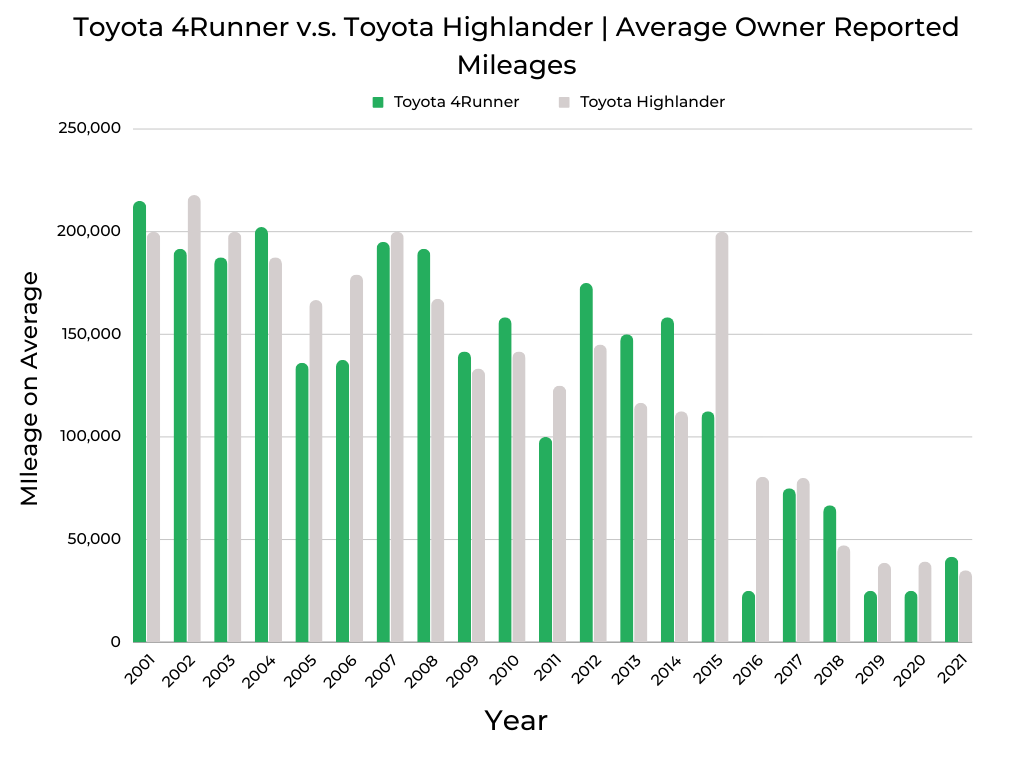
Low FIXD Reliability Scores don’t stand in the way of older 4Runners and Highlanders in the way of these Toyotas packing on the miles. Many cross the 150,000-mile threshold, while some model years have approached or passed 200,000 miles. Frankly, this is what I would expect for Toyota-built utility vehicles.
To double-check 4Runner and Highlander longevity, I took an unscientific look at online for-sale listings. A visit to autotrader.com (December 19, 2023) shows 1,030 4Runners and 1,143 Highlanders from the 2001-2012 model years available. Older examples are more likely to have more miles.
Sorting through the listings shows 323 (31.4%) 4Runners and 216 (18.9%) Highlanders with at least 200,000 miles. There are unusually high percentages (especially for the 4Runner) compared to what I typically see when analyzing passenger cars.
High-mileage (200,000+ miles) sedans, hatchbacks, and the like usually account for less than 10% of available listings. On the other hand, a recent comparison of the Toyota Tundra and Toyota Tacoma showed similar percentages of high-mileage examples like the 4Runner and Highlander.
Another look at the online listings shows plenty of 4Runners (363 or 35.2%) and Highlanders (436 or 28.1%) with 150,000-200,000 miles.
Translation: If you want to drive a Toyota until the wheels fall off, buy a 4Runner, Highlander, Tundra, or Tacoma. These vehicles should last beyond 200,000 miles, assuming ownership includes routine maintenance and thoughtful driving.
Review the individual articles on the best and worst years of the Toyota 4Runner and Toyota Highlander for a more thorough look at longevity.
Who Should Buy These Cars: The Legacy of the Toyota 4Runner Vs. Toyota Highlander
According to FIXD surveys, almost half of Highlander owners use their cars for family transportation, compared to slightly more than a third of 4Runner owners. Meanwhile, about one-fourth of the owners of both vehicles are involved in “lots of driving,” which means longer commutes and road trips.
There are also some towing and hauling activities, with 11% of Highlander owners involved (8% for the 4Runner). Unsurprisingly, almost one in five 4Runner owners rely on their SUV’s extra-rugged capabilities for off-road adventures.
I can sum up the 4Runner and Highlander in one word: versatile.
| Frequent Use Categories: | Toyota 4Runner | How Useful? (Out of 5 Stars) |
Toyota Highlander| How Useful? (Out of 5 Stars) |
| Family Vehicle | * * * * | * * * * * |
| Lots of Driving (travel/long commute) | * * * | * * * |
| Hauling/Towing | * | * * |
| Office on Wheels | * | * |
| Sport/Fast Driving | * | * |
| Luxurious Driving | * | * |
| Outdoor/Off-Road | * * | * |
Driver Experience | A Summary of The Top 10 Toyota 4Runner Vs. Toyota Highlander Reddit Posts:
There’s no shortage of Reddit comments comparing the 4Runner and Highlander. Here are the highlights of some recent discussions from Reddit: r/whatcarshouldIbuy.
Regarding capability, the Toyota 4Runner is generally regarded as the superior off-road vehicle between the two. One user commented, “The 4Runner is a true body-on-frame SUV made for off-roading. The Highlander is a crossover made for the suburbs.” The 4Runner sits higher off the ground, has better approach and departure angles, and is better equipped for rough terrain. Many users note that the 4Runner can go places “no Highlander could even dream of” thanks to its 4WD system, locking rear differential, and off-road-tuned suspension. However, the tradeoff is that the 4Runner’s truck-based nature makes it less comfortable on pavement than the Highlander.
The consensus for daily driving and family hauling duties seems to be that the Highlander is the more sensible option. One Redditor said, “The Highlander is bigger inside for hauling kids and stuff.” The Highlander offers more passenger and cargo space with its lower cargo floor and a car-based design. It also gets significantly better gas mileage, with many pointing out the “horribly inefficient” nature of the 4Runner’s engine. Quotes like “Highlander will be cheaper to own long term from a gas and maintenance perspective” illustrate the Highlander’s practicality advantage. However, the Highlander is still regarded as highly capable in foul weather and light off-road conditions like dirt roads or snow— just not extreme rock crawling.
When it comes to reliability and resale value, both SUVs score very well, but the 4Runner seems to have a slight edge. As one user claimed, “The 4Runner is known to go 300k+ miles if properly maintained.” And thanks to its reputation for indestructibility and loyal following, several Redditors mentioned that things like “4Runners hold their value insanely well, so you’ll get more back if/when you sell.”
Best & Worst Years | Toyota 4Runner Vs. Toyota Highlander | 2001-2024

There are few choices for a cheap 4Runner or Highlander, but at least there are options. A prospective buyer will want to focus on a 2003-2004 4Runner or 2002 Highlander. Moving up to newer examples requires deeper pockets. In this case, a 2007-2008 4Runner or a 2007 or 2009-2010 Highlander.
From 2012-2021, the offerings expand for the 4Runner; you’ll just want to avoid the 2016 and 2019 model years. Yet, the later Highlanders are more off and on. The examples to focus on are from 2012, 2015, 2017, 2019, and 2021.
I’ll call attention to the undecided years (yellow) only because there isn’t enough information to give these editions a thumbs up or down.
Important Features Timeline | Toyota 4Runner Vs. Toyota Highlander
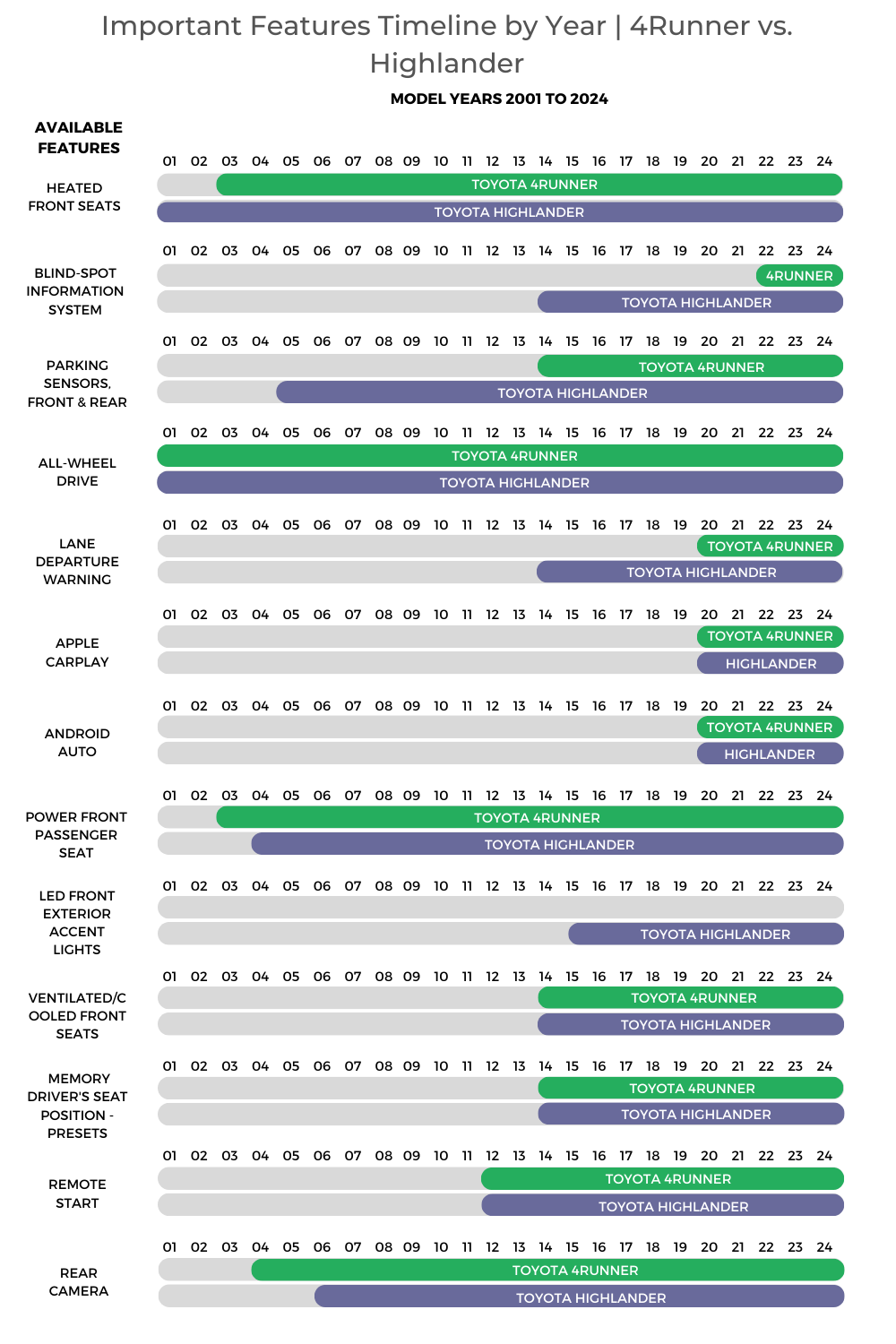
The Highlander’s claim to fame is serving as a family vehicle. So, seeing it get certain safety features (blind-spot monitoring, lane departure warning, and parking sensors) before the 4Runner is to be expected.
However, it’s important to remember that the 4Runner’s higher starting prices give it greater status in Toyota’s lineup. As a result, it’s not unusual for the less-sophisticated 4Runner to get some comfort and convenience features before or at the same time as the Highlander. In particular, the 4Runner got a power front passenger seat before the Highlander.
Yet, both vehicles received ventilated front seats and a driver’s memory system in 2014. In addition, both cars were a little behind the times by not getting Apple CarPlay and Android Auto until 2020.
Maintenance Costs (Year-by-Year Average) | Toyota 4Runner Vs. Toyota Highlander
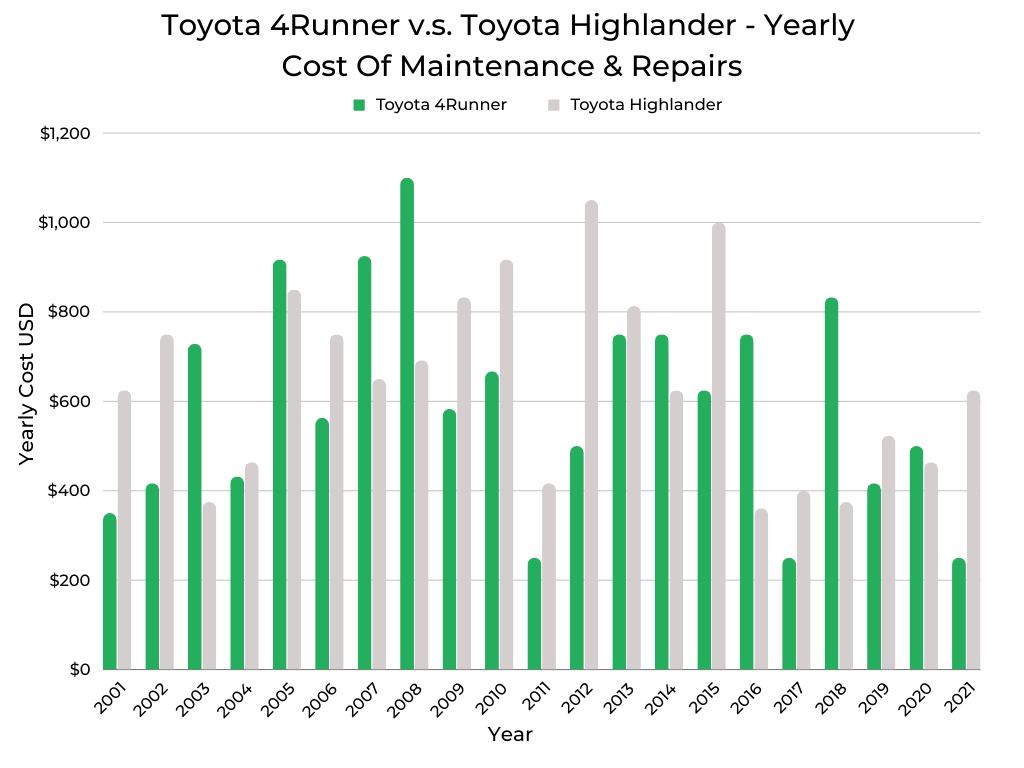
Average maintenance and repair costs in 2022, according to FIXD owner surveys, were $598 for the 4Runner and $646 for the Highlander. These outlays are quite reasonable for SUVs and closer to what an owner of a passenger car might pay. For example, the Toyota Camry has an average of $591. Generally, the larger and more complex a vehicle, the more expensive the maintenance and repair bills. Nonetheless, the 4Runner and Highlander defy this assumption.
However, moving beyond averages uncovers that specific model years had higher upkeep costs. For instance, owners of 2003, 2005, 2007, 2008, 2013, 2014, 2016, and 2018 4Runners all spent at least 20% above average to maintain their vehicles; the 2008 model year had the highest costs at $1,100.
The Highlander doesn’t escape this issue either. Owners with 2005, 2009, 2010, 2012, 2013, and 2015 editions also paid 20% or more to keep their cars on the road. The 2012 Highlander was particularly expensive, with an average repair bill of $1,050.
A glance at these above-average years shows one thing. Higher maintenance and repair bills aren’t restricted to the oldest models.
Review the best and worst years of the Toyota 4Runner and Toyota Highlander to learn more about maintenance and repair costs for these vehicles.
Safety Rating Comparison | Toyota 4Runner Vs. Toyota Highlander
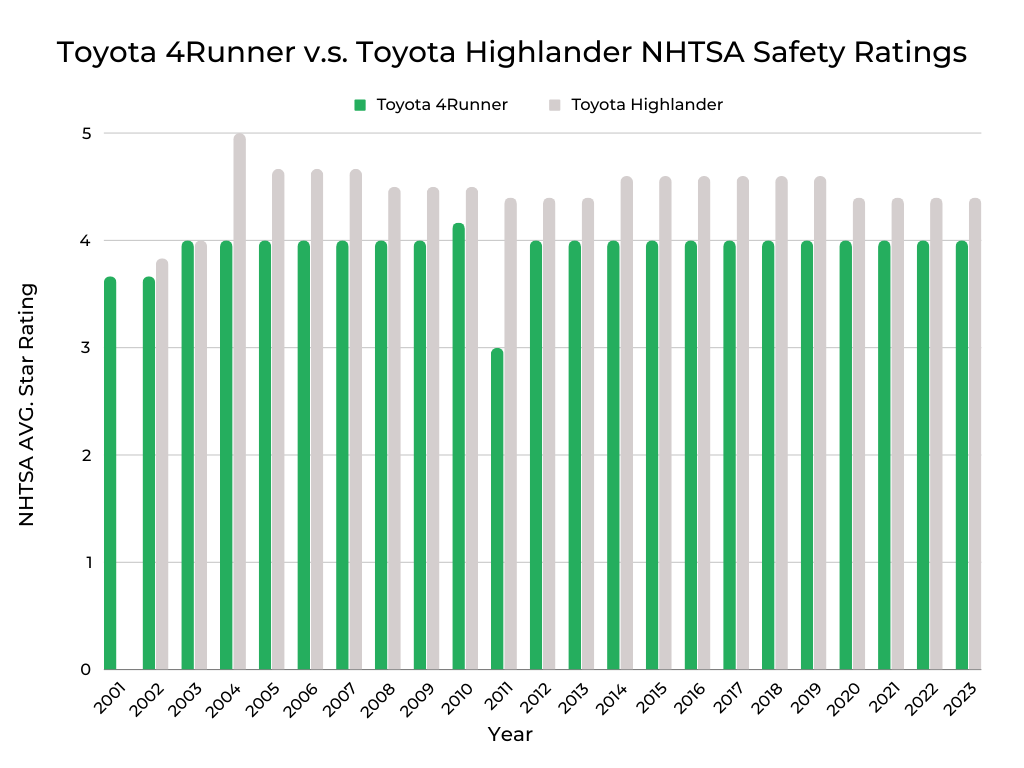
While a car buyer may be focused on features, fuel economy, or other characteristics, being aware of a prospective vehicle’s safety scores is always a good idea. Overall, the 4Runner and Highlander do well in testing by the National Highway Traffic Safety Administration (NHTSA). Of course, a perfect 5 out of 5 rating is always ideal, but the chart shows this isn’t attainable (except for the 2004 Highlander). Nonetheless, any model year with at least a 4 is still worthwhile.
However, if the best possible safety scores are a must-have, then the Highlander is the obvious winner. Clearly, Toyota engineers worked overtime to have the family-focused Highlander do well in government crash tests.
The 2011 4Runner’s poor showing is due to more comprehensive testing instituted by NHTSA for that year. This change also affected many other vehicles, but Toyota ensured the Highlander didn’t skip a beat.
More details about crash test safety scores are covered in articles about the Toyota 4Runner and Toyota Highlander.
Fuel Efficiency Comparison | Toyota 4Runner Vs. Toyota Highlander
The Toyota 4Runner has many strong points, but fuel economy isn’t one of them—sub-20 MPG fuel economy is painful at the pump. However, that’s the price of owning a heavy vehicle, usually further weighed down by four-wheel-drive running gear.
The Highlander wasn’t much better in its early years, but even the 10%–15% improvement in fuel economy added up over time. In addition, the launch of the third-generation Highlander for the 2014 model year showed this SUV pulling further ahead of the 4Runner regarding fuel economy. Between the 4Runner and Highlander, there’s no dispute about which requires fewer fill-ups.
This factor is amplified when looking at the gas usage of the Highlander Hybrid. The fuel economy ratings of 26-29 MPG for the 2006-2019 editions are a significant improvement over the 4Runners from the same years. However, the Highlander truly leaves the 4Runner in the dust with the arrival of the fourth generation and more advanced hybrid technology for 2020. Frankly, 35 MPG is astounding in a vehicle of this size.
Expect hybrid technology to arrive in the 4Runner when the next generation comes in 2025.
- Compare two vehicles, Toyota 4Runner and the Toyota Highlander, and provide a comprehensive analysis.
- Gather relevant information and data on both vehicles from reliable sources, such as manufacturer specifications, expert reviews, customer feedback, industry reports, and data sources like manufacturer websites, FIXD App, Kelley Blue Book, FuelEconomy.gov, and NHTSA.
- Collect data on various aspects, including performance, safety features, fuel efficiency, maintenance costs, reliability, owner satisfaction, and market value.
- Identify the key criteria that will be used to evaluate and compare the two vehicles.
- Ensure the criteria cover both objective factors (such as performance metrics, safety ratings, and fuel efficiency) and subjective factors (such as owner satisfaction, comfort, and features).
- Assess the performance of both vehicles based on factors such as acceleration, handling, braking, and overall driving experience.
- Compare engine options, horsepower, torque, transmission options, and any unique performance features.
- Examine the safety features and ratings of both vehicles.
- Evaluate crash test ratings, advanced driver assistance systems (ADAS), active and passive safety features, and any notable recalls or known issues related to safety.
- Consider both NHTSA safety ratings and IIHS awards for a comprehensive safety assessment.
- Analyze the fuel economy of both vehicles based on EPA mileage estimates.
- Compare their MPG ratings, average full-tank range, and any significant differences in fuel efficiency.
- Assess the average annual maintenance and repair costs for both vehicles.
- Consider data from surveyed owners and other reliable sources, such as FIXD App owner surveys, to determine the overall cost of ownership over time.
- Evaluate the reliability of both vehicles based on owner reports, FIXD App data, and any known issues or recalls.
- Consider factors such as engine reliability, common problems by model year, long-term durability, and owner reliability scores gathered from surveys.
- Consider owner satisfaction by gathering information from forums, online communities (Reddit: r/whatcarshouldIbuy), customer reviews, and owner reliability scores.
- Summarize key factors that owners appreciate and any common complaints or drawbacks mentioned by owners.
- Compare the features and technologies offered by both vehicles.
- Highlight any notable differences in terms of infotainment systems, connectivity options, driver assistance features, interior quality, and available upgrades.
- Assess the market value and depreciation of both vehicles.
- Compare average prices, resale value, and how the vehicles hold their value over time.
- Consider average private-seller valuations from Kelley Blue Book (KBB) for a comprehensive assessment.
- Summarize the findings of the comparison, highlighting the positives and negatives of each vehicle.
- Provide a fair and balanced recommendation based on the comparison, considering factors such as budget, personal preferences, specific needs of the buyer, and the comprehensive analysis conducted.
Sources:
- KBB Values: Average private-seller valuations as supplied by Kelley Blue Book (KBB), based on a Toyota 4Runner and Toyota Highlander with typical mileage for that respective model year.
- Fuel Economy: Mileage-per-gallon estimates according to the EPA MPG on Fueleconomy.gov.
- Annual Maintenance/Repairs: Upkeep expenses as reported by surveyed “Toyota 4Runner and Toyota Highlander owners.
- Safety Ratings: Crash test data collected and reported by NHTSA. We average all ratings for each year to come up with a simplified, average safety score. This makes it easier to look at on a graph. We also collected IIHS Awards for this article.

Dave Goldberg is an automotive journalist and lifelong car fanatic. He writes for numerous enthusiast and business outlets and is an ongoing contributor to HotCars.com, one of the most popular car culture websites. When he’s not writing or driving, Dave is either under a hood or asleep. His credentials include a BA in Journalism from The George Washington University.

